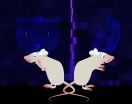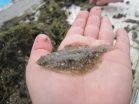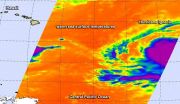(Press-News.org) Cold Spring Harbor, NY - When a large combat unit, widely dispersed in dense jungle, goes to battle, no single soldier knows precisely how his actions are affecting the unit's success or failure. But in modern armies, every soldier is connected via an audio link that can instantly receive broadcasts - reporting both positive and negative surprises - based on new intelligence. The real-time broadcasts enable dispersed troops to learn from these reports and can be critical since no solider has an overview of the entire unit's situation.
Similarly, as neuroscientists at Cold Spring Harbor Laboratory (CSHL) have just discovered, there are a set of dedicated neurons in the basal forebrain that broadcast a message throughout the cerebral cortex, rapidly informing multiple distributed subregions of any surprising rewards or punishments - what scientists call reinforcers.
The neurons in question are cholinergic, and the team, led by Associate Professor Adam Kepecs, has succeeded in recording their activity for the first time in behaving animals (mice).
Cholinergic neurons form one of the brain's several neuromodulatory systems - they send signals in the form of the neurotransmitter acetylcholine to broad swaths of the brain. Although they have been thought to play an important role in arousal, attention and learning, their precise role in behavior has remained mysterious - in part, because of the technical difficulty in recording from them in vivo. Degeneration and loss of cholinergic neurons in the basal forebrain has been implicated in Alzheimer's disease, age-related cognitive decline, and other cognitive disorders and dementias.
In a paper published online today in Cell, Kepecs and colleagues report on how central cholinergic neurons function, using optogenetic neuron identification --a technique in which mouse neurons are genetically engineered to respond to light. "These are very, very, difficult-to-find neurons, and they form an incredibly important system in the brain," Kepecs says. "Until recently we didn't have the techniques to approach this system with the precision required."
Once they identified cholinergic neurons, the team recorded their activity while mice performed a sound detection task requiring sustained attention. Depending on whether their response was correct or not, mice were either rewarded with drop of water or "punished" with a mild puff of air to their face. Postdoctoral fellow Balazs Hangya of the Kepecs lab discovered that these neurons respond to reward and punishment, with unusual speed and precision, taking only a few thousandths-of-a-second.
To explain the responses researchers constructed a computational model which revealed that the modulation of the signal strength was proportional to how unexpected or surprising the mice found the reward or punishment. According to the model, if the mice were certain their response was correct, the reward generated a weak signal. But if they were unsure, the reward came as more of a surprise and generated a stronger cholinergic signal. "This suggests to us that it's not really about punishment, per se, but it's simply that punishment usually is more surprising," Kepecs says.
Kepecs suggests that cholinergic broadcasts to the cortex would be useful in boosting plasticity, allowing flexibility in neuronal connections that makes learning possible. Whether the surprise registers an outcome or event that was better or worse than expected, the fact it was unexpected, and the degree to which it was, is an obvious advantage to the individual - as, indeed, constant intelligence is to soldiers in the unit enmeshed in jungle combat.
INFORMATION:
This work was supported by grants from the John Merck and McKnight Foundations and the National Institute of Neurological Disorders and Stroke (National Institutes of Health) grant R01NS075531; the Swartz Foundation; and Marie Curie International Outgoing Fellowship
within the EU Seventh Framework Programme for Research and Technological Development.
"Central cholinergic neurons are rapidly recruited by reinforcement feedback" appears online in Cell on August 27, 2015. The authors are: Bala?zs Hangya, Sachin P. Ranade, Maja Lorenc and Adam Kepecs. The paper can be obtained online at http://www.cell.com/cell/newarticles
About Cold Spring Harbor Laboratory
Celebrating its 125th anniversary in 2015, Cold Spring Harbor Laboratory has shaped contemporary biomedical research and education with programs in cancer, neuroscience, plant biology and quantitative biology. Home to eight Nobel Prize winners, the private, not-for-profit Laboratory is more than 600 researchers and technicians strong. The Meetings & Courses Program hosts more than 12,000 scientists from around the world each year on its campuses in Long Island and in Suzhou, China. The Laboratory's education arm also includes an academic publishing house, a graduate school and programs for middle and high school students and teachers. For more information, visit http://www.cshl.edu
LA JOLLA--Every organism--from a seedling to a president--must protect its DNA at all costs, but precisely how a cell distinguishes between damage to its own DNA and the foreign DNA of an invading virus has remained a mystery.
Now, scientists at the Salk Institute have discovered critical details of how a cell's response system tells the difference between these two perpetual threats. The discovery could help in the development of new cancer-selective viral therapies and may help explain why aging and certain diseases seem to open the door to viral infections.
"Our ...
Working with human cancer cell lines and mice, researchers at the Johns Hopkins Kimmel Cancer Center and elsewhere have found a way to trigger a type of immune system "virus alert" that may one day boost cancer patients' response to immunotherapy drugs. An increasingly promising focus of cancer research, the drugs are designed to disarm cancer cells' ability to avoid detection and destruction by the immune system.
In a report on the work published in the Aug. 27 issue of Cell, the Johns Hopkins-led research team says it has found a core group of genes related to both ...
Understanding exactly what is taking place inside a single cell is no easy task. For DNA, amplification techniques are available to make the task possible, but for other substances such as proteins and small molecules, scientists generally have to rely on statistics generated from many different cells measured together. Unfortunately, this means they cannot look at what is happening in each individual cell.
Now, thanks to seven years of work done at the RIKEN Quantitative Biology Center and Hiroshima University, scientists can take a peek into a single plant cell and--within ...
In experiments with mouse tissue, UC San Francisco researchers have discovered that the adaptive immune system, generally associated with fighting bacterial and viral infections, plays an active role in guiding the normal development of mammary glands, the only organs--in female humans as well as mice--that develop predominately after birth, beginning at puberty.
The scientists say the findings have implications not only for understanding normal organ development, but also for cancer and tissue-regeneration research, as well as in the highly active field of cancer immunotherapy, ...
Philadelphia, PA, Aug 27, 2015 - Having twins accounts for only 1.5% of all births but 25% of preterm births, the leading cause of infant mortality worldwide. Successful strategies for reducing singleton preterm births include prophylactic use of progesterone and cervical cerclage in patients with a prior history of preterm birth. To investigate whether the use of a cervical pessary might reduce premature births of twins, an international team of researchers conducted a large, multicenter, international randomized clinical trial (RCT) of approximately 1200 twin pregnancies. ...
DURHAM, N.H. - Researchers at the University of New Hampshire are turning to an unusual source --otoliths, the inner ear bones of fish -- to identify the nursery grounds of winter flounder, the protected estuaries where the potato chip-sized juveniles grow to adolesence. The research, recently published in the journal Transactions of the American Fisheries Society, could aid the effort to restore plummeting winter flounder populations along the East Coast of the U.S.
In addition to showing the age of a fish, much like the rings in the cross-section of a tree, otoliths ...
When cloud top temperatures get colder, the uplift in tropical cyclones gets stronger and the thunderstorms that make up the tropical cyclones have more strength. NASA's Aqua satellite passed over Hurricane Ignacio and infrared data revealed cloud top temperatures had cooled from the previous day.
Ignacio strengthened to a hurricane at 11 p.m. EDT on August 26. It became the seventh hurricane of the Eastern Pacific Ocean hurricane season.
A false-colored infrared image of Hurricane Ignacio was made at NASA's Jet Propulsion Laboratory in Pasadena California, using data ...
Researchers from the Gladstone Institutes have revealed that HIV does not cause AIDS by the virus's direct effect on the host's immune cells, but rather through the cells' lethal influence on one another.
HIV can either be spread through free-floating virus that directly infect the host immune cells or an infected cell can pass the virus to an uninfected cell. The second method, cell to cell transmission, is 100 to 1000 times more efficient, and the new study shows that it is only this method that sets off a cellular chain reaction that ends in the newly infected cells ...
At a time when cancer drug prices are rising rapidly, an innovative new study provides the framework for establishing value-based pricing for all new oncology drugs entering the marketplace. Using a highly sophisticated economic model, researchers from Winship Cancer Institute of Emory University and Georgia Institute of Technology used an example of a new lung cancer drug. The study findings will be published August 27, 2015 in JAMA Oncology.
Researchers focused their investigation on a drug called necitumumab, which is awaiting approval from the U.S. Food and Drug ...
Use of the 21-gene recurrence test score was associated with lower chemotherapy use in high-risk patients and greater use of chemotherapy in low-risk patients compared with not using the test among a large group of Medicare beneficiaries, according to an article published online by JAMA Oncology.
National Comprehensive Cancer Network (NCCN) guidelines recommend considering chemotherapy in estrogen receptor (ER)-positive, node-negative breast cancer for all but the smallest tumors. Several studies have suggested the 21-gene recurrence score assay (testing) is cost-effective ...



